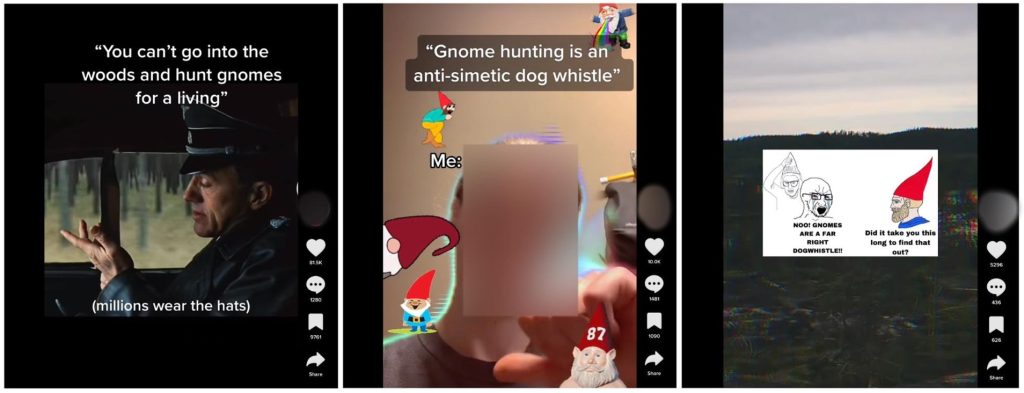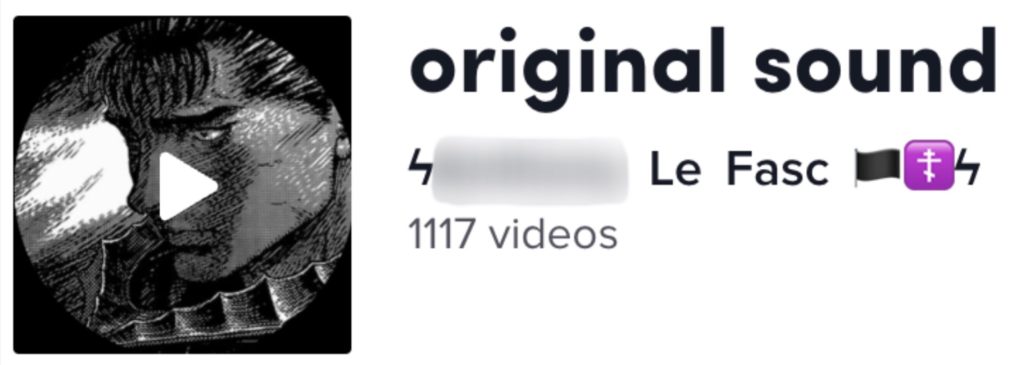Introduction
In April 2023, a concerning trend emerged on TikTok called ‘gnome hunting’. While at face value, the trend depicted users harmlessly pretending to hunt for gnomes, the trend was steeped in antisemitism. In this context, gnomes served as coded references to Jewish people, and gnome hunting referred to hunting for Jews. Gnome hunting followed other contemporary trends of online antisemitic dog whistles such as #thenoticing and the echo. The coded meaning of gnome hunting allowed for its rapid growth, due to participation from TikTok users who were unaware of its violent, antisemitic connotations. We identified gnome hunting TikToks with over 1.7 million views, indicating that this hateful trend reached an audience far beyond niche extremist communities.
It is not unusual for TikTok users to collectively participate in an absurdist meme of the month. Millions of users partook in the ‘Woodchuck Revolution’ trend in 2021, which manifested complicated plotlines and even accompanying musical compositions. In late 2022, the app was inundated with memes describing a made-up economic system using a currency called ‘doubloons’. Given this context, it is unsurprising that TikTok users jumped at the chance to participate in the gnome hunting meme without understanding its hateful message. Some creators have since removed their original gnome hunting videos and apologised for unwittingly participating in a hateful trend.
This Insight will explain how far-right groups adopt dog whistles to avoid content moderation efforts and obscure harmful meanings to both moderators and wider users. TikTok’s gnome hunting trend will serve as a case study for this tactic while demonstrating how seemingly benign trends may be based on virulently antisemitic and extremist ideologies.
Dog Whistles and Violent Extremist Content
A dog whistle is coded or suggestive language that is understood by a particular in-group while its meaning(s) remain opaque to the out-group. Dog whistles often build on or reference pre-existing ideological tenets that individuals in the in-group would understand. In October 2022, 4chan users utilised and popularised the #thenoticing hashtag, an antisemitic dog whistle, on Twitter. ‘The noticing’ refers to the instance in which individuals allegedly ‘notice’ the presence of a machiavellian Jewish conspiracy. Similarly, in 2014, online antisemites began using the ‘echo’ or parentheses around Jewish names, for example ‘(((George Soros))))’, as a way to subtly whisper their antisemitic beliefs to other antisemites.
While dog whistles are useful for extremist attempts to evade content moderation efforts, with time, their true meaning often becomes known, as was the case with the echo parentheses, the noticing, and gnome hunting. As a result, different dog whistles and other examples of coded language are in a constant state of fluctuation online.
The Rise of TikTok’s Gnome Hunting
Although some instances of TikTok gnome hunting acted as coded antisemitic dog whistles, other gnome hunting content was overtly neo-Nazi and antisemitic in nature. Additionally, gnome hunting is a continuation of recent references to gnomes in extremist spaces on Telegram and TikTok. Prior manifestations of this gnome fascination include the ‘gnomecore’ and ‘gnomepill’ trends which utilise gnomes as coded references to extremist narratives that wish to return to or embrace tradition. Although this content originally emphasised a desire to ‘find the gnomes’, portrayed as benevolent creatures and symbols of pre-modern Europe, the current gnome hunting trend shows that gnomes have since been reconfigured as adversarial actors – specifically Jewish people. In this section, we will provide an overview of the most prominent antisemitic indicators identified in this trend, including the phrase “millions wear the hats”, far-right insignia, and antisemitic and neo-Nazi hashtags.
‘Millions wear the hats’
The most prominent of these indicators is the frequent use of the phrase “millions wear the hats”, displayed either in the TikTok video or its caption. This phrase serves as a coded reference to yarmulkes traditionally worn by some Jewish people by highlighting the pointy caps most often donned by garden gnome statues. “Millions” refers to the global Jewish population and the perception of a global Jewish conspiracy of world domination involving millions of people. Other captions expand on the consequences of this conspiracy, stating “billions deny, trillions will suffer” and “billions must die,” conveying that genocidal violence will be levelled toward Jewish people as retribution for the conspiracy.
Neo-Nazi Insignia

Figure 1. TikToks showing users wearing Sonnenrads, skull masks, and two emoji lightning bolts, or the double Sig/Sowilo rune, communicating sympathies towards the Nazi SS
Other extremist indicators demonstrated by both gnome hunting focused TikToks and participating users include Sonnenrads, skull masks, and two emoji lightning bolts, or the double Sig/Sowilo rune, communicating sympathies towards the Nazi SS (Fig.1). These symbols frequently appear in neo-fascist, eco-fascist, and militant accelerationist milieus to convey adherence to extremist ideologies while evading content moderation efforts. Similarly, the presence of pine tree emojis, often used to convey an allegiance to violent eco-fascist ideology, further illustrates the conflation of the gnome hunting meme with extremist trends.
Hashtags
Numerous gnome hunting TikToks were posted alongside overtly antisemitic and neo-Nazi hashtags, such as rhetoric about an ‘Aryan’ race, nods to Adolf Hitler as an ‘artist’, or the names of other notable members of the Nazi party. The videos also featured notable Nazi villains from popular culture such as Hans Landa, the fictional SS officer in the film Inglorious Basterds and Karl Ruprect Kroenen, the fictional supervillain from the Hellboy comic series (Fig.2).

Figure 2. Tiktok videos showing Nazi villains from popular culture such as Hans Landa, the fictional SS officer in the film Inglorious Basterds and Karl Ruprect Kroenen, the fictional supervillain from the Hellboy comic series.
Audio
The audios layered underneath gnome hunting videos on TikTok further demonstrate the trend’s antisemitic nature. We discovered TikToks set to recordings of Adolf Hitler’s speeches and containing imagery of Nazi Germany, such as German athletes lighting the Olympic Torch at the 1936 Olympics (Fig.3).

Figure 3. The above TikTok screenshot shows Nazi imagery, and gnome hunting phrases. The audio paired with this footage was from a speech given by Adolf Hitler.
Other gnome hunting TikToks are overlaid with original songs created by overtly fascist users, identifiable through the use of double lightning bolts emojis or terms in their usernames (Fig.4), and with titles such as ‘Third Strike’. Notably, a prior title for the song was ‘Third Rike’, reflecting other patterns in content moderation evasion tactics. The song is now not available to use on the platform.

Figure 4. User-created sound frequently used in gnome hunting TikToks, created by an overtly fascist user.
Schizowave
Gnome hunting has ties to other extremist social media trends on TikTok, including the ‘schizowave’ aesthetic. In addition to antisemitic hashtags, gnome hunting TikToks were frequently posted alongside references to schizowave and schizoposting, a defined trend on social media whereby users hyperbolically or ironically assert that they are ‘insane’ or ‘hearing voices’. The schizowave aesthetic is based on a false depiction of schizophrenia as a mood disorder that inherently valorises and leads to violence. As a result, schizoposting and schizowave content depicts an imagined experience of disconnecting from reality. On TikTok, this content typically features strobe lights, rapid cuts, and techno music. It is designed to convey chaos and incomprehensibility while being gripping and shareable. This aesthetic has been tied to previous instances of mass violence, including the July 2022 Highland Park shooting. While not all schizo-related content is violent or extremist in nature, its popularity on TikTok is still notable. The hashtag ‘schizoposting’ alone has over 1 billion views. These hashtags signal a convergence of the two trends and the communities that utilise them.
Conclusion
The gnome hunting meme is a pertinent example of how subtle dog whistles can lead to widespread participation in hateful messaging, regardless of the participant’s intent. The gnome hunting trend is associated with overt hate symbols, such as SS bolts and skull masks, and should never have been allowed to spread as far as it has. Social media companies like TikTok should be aware of emerging trends in violent rhetoric on their platforms and prioritise the mitigation of these trends before they become mainstream.
